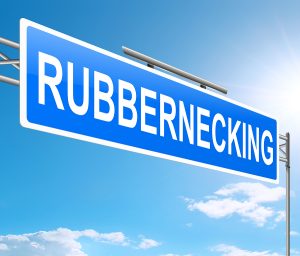What Is Rubbernecking?
 Michael Babboni
Personal Injury
Rubbernecking is when a person turns their head to stare at something in a foolish manner. This often happens when driving down the road and approaching an accident scene. The driver may slow down to turn and look at the wreckage.
Michael Babboni
Personal Injury
Rubbernecking is when a person turns their head to stare at something in a foolish manner. This often happens when driving down the road and approaching an accident scene. The driver may slow down to turn and look at the wreckage.Is Rubbernecking Illegal?
No, rubbernecking isn't exactly illegal. However, it can be considered an act of negligence if it results in an accident. If that accident caused by rubbernecking causes bodily injury to another, then the person doing the rubbernecking may be held liable for the other person's injuries.
Is Rubbernecking Dangerous?
Yes. Approximately 1000 people in the US are injured daily while distracted driving. Researchers have found that rubbernecking causes an estimated 10 to 16 percent of all car accidents.
While it may be difficult to find more statistics about rubbernecking, it is a dangerous act because it is a distraction that can cause an accident. When you are not fully focused on driving and take your eyes away from the road, you are at an increased risk of being involved in an auto accident.
Rubbernecking is a form of distracted driving. It causes a cognitive distraction. This happens when the driver's mind is focused on something other than the driving task. It can be hard to control your natural curiosity when passing an accident scene, so rubbernecking is a common cause of accidents.
Collisions Resulting from Rubbernecking
A rear-end collision is one of the more common collisions that occur due to rubbernecking. These accidents can cause serious neck and back injuries. When serious, these kinds of injuries may also result in surgery.
How to Stop Rubbernecking
Here are just a few ways to stop rubbernecking and lessen your risk of being involved in an auto accident.
Keep Your Eyes on the Road
Even at slower speeds, you need to keep your eyes on the road at all times. Don't let an accident scene you pass become a distraction. Avoid staring at the other vehicles as you pass by, which can help prevent another accident.
You can also slow down more when passing an accident and increase your following distance. Be extra vigilant. The only time you should stop your vehicle is if you were a witness to the accident or you are going to supply aid.
Practice Defensive Driving
When you approach an accident scene, drive defensively. This means being aware of your surroundings. Assume that the cars around you will break the law or rubberneck themselves. Assume the drivers around you are looking at the accident as they pass by rather than the road.
Reduce your speed, use your turn signals when changing lanes, and always be prepared to make necessary maneuvers as you pass by the accident scene or when you need to get away from distracted drivers. Be prepared to stop at a moment's notice.
Distracted Driving Accidents
Even when you take all the right precautions and practice safe driving habits, you can't control what the other motorists around you do. If you get into an accident because the driver at fault was rubbernecking, you may be owed compensation for the injuries sustained as well as the damages.
The distracted driver's insurance may need to compensate for property repairs, a vehicle replacement, medical bills, and lost wages. If you were involved in this kind of accident, consult with an experienced personal injury attorney.
An attorney can assist you with your claim and help you prove that rubbernecking was the cause of your accident.
